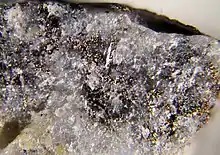Stannoidite
Stannoidite is a sulfide mineral composed of five chemical elements: copper, iron, zinc, tin and sulfur. Its name originates from Latin stannum (tin) and Greek eides (or Latin oïda meaning "like"). The mineral is found in hydrothermal Cu-Sn deposits.[1][2]
| Stannoidite | |
|---|---|
 | |
| General | |
| Category | Sulfide mineral |
| Formula (repeating unit) | Cu6+Cu22+(Fe2+,Zn)3Sn2S12 |
| Strunz classification | 2.CB.15c |
| Crystal system | Orthorhombic |
| Crystal class | Disphenoidal (222) H-M symbol: (2 2 2) |
| Space group | I222 (No. 23) |
| Unit cell | a = 10.76 Å, b = 5.4 Å c = 16.09 Å, Z = 2 |
| Identification | |
| Color | Brass brown |
| Crystal habit | Uniformly indistinguishable crystals forming large masses |
| Cleavage | None |
| Fracture | Conchoidal – uneven |
| Mohs scale hardness | 4 |
| Luster | Metallic |
| Streak | Brown gray |
| Diaphaneity | Opaque |
| Specific gravity | 4.29 |
| References | [1][2][3] |
Stannoidite was first described in 1969 for an occurrence in the Konjo mine, Okayama prefecture, Honshu Island, Japan.[2]
References
| Wikimedia Commons has media related to Stannoidite. |
- Stannoidite. Webmineral
- Stannoidite. Mindat.org
- Kudoh Y., Takeuchi Y. (1976). "The superstructure of stannoidite". Zeitschrift für Kristallographie – Crystalline Materials. 144 (1–6): 145. Bibcode:1976ZK....144..145K. doi:10.1524/zkri.1976.144.16.145.
This article is issued from Wikipedia. The text is licensed under Creative Commons - Attribution - Sharealike. Additional terms may apply for the media files.
